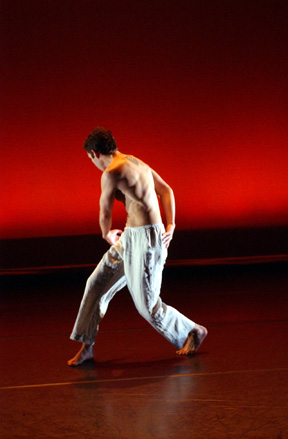Neck and Cheek
Ruben
Graciani: Search for my Familiar
Making Dances / Taking Chances Series
Dance Theatre, Clarice Smith Performing Arts Center
The University of Maryland
College Park, Maryland, USA
Thursday, November 11, 2004
by George Jackson
copyright
© 2004 by George Jackson

All these things were apparent at the start of the program in a dance
to the music of a composer who has the reputation of bringing out the
best in choreographers, Johann Sebastian Bach. To the concise F minor
orchestral concerto, Mr. Graciani made movement for five women and himself.
He both acknowledged and ignored the gender imbalance. There was plenty
of partnering, with some of the holds not at all conventional. One type
had the partner's hands around the neck of the dancer being partnered,
another had the hands pressed to the opposite's cheeks. These maneuvers
seemed under firm control by the choreographer for they displayed wit
without being excessively funny. In fact, Mr. Graciani presented them
so nonchalantly that one wondered why those parts of the anatomy aren't
used more often for contact and support.
Actually, they're not brand new. Mr. Graciani himself deployed neck and
cheek holds in his March work to the same music. That, though, was a different
dance, one filled with incidents of drama. Now, in November, the story
episodes are gone although the maneuvers remain, and they look good abstracted.
Overall, this "pure" dance piece to Bach is built from discreet
choreographic themes such as flat vertical stances with outstretched arm
and flexed hand, and stretched out bodies lying prone. The themes develop
into dancing for the full human form moving through the entire space scale,
air to floor. Each of the concerto's sections has not just its distinct
pace but also its own floor patterns and singular mood. A sense of confident,
clean, semi-casual asymmetry reigns, and it suits the music. My only quibble
is with the dance's title, "...in the face of unrelenting optimism".
It bears no relation to what viewers now see.
At the program's close, Mr. Graciani again cast a very dancy work with
himself and women, six this time. He wasn't, however, in a rut. This piece
did have an unrelenting aspect, intentionally and humorously so. Its music,
from Antonin Dvorak's A minor violin concerto, was grandly, ideally romantic.
There were two portions, one danced in a hyper-peaceful and ultra-placid
mood, whereas the other was fraught with joy. In the first, the dancers
wore white dress shirts, white underbriefs. They seemed to be the blessed
spirits of people who had been ditsy in their lives; imagine Gracie Allen's
and Lucille Ball's ghosts giving you serious advice. The words of a text
spilled over them and onto the wall behind. Its message seemed an over-the-top
yet not total parody of Friedrich Schiller's "Ode to Joy", the
poem Ludwig van Beethoven set as the finale of his 9th symphony. Mr. Graciani
titled this work "A Deafening Joy". In its second portion, the
dancers wore red tunics over yellow briefs and looked like they were earnestly
rehearsing for a bacchanal. Or was it for the ROTC?
Between these group dances were two solos and a duet. The duet, "Long
Ride Home" to Cesar Frank's A minor violin sonata, is for two men
dressed almost identically. The black tanktops above their white trousers
were of slightly different cut. The men have different builds. One, Alexander
Gish, is muscular, solid and the other, Mr. Graciani, is flat, linear
and seemed taller although he isn't of a significantly different height.
The dancing built on the music's yearning. When there was partnering,
Mr. Gish served as base. To his solo passages he gave a rich plasticity.
Particularly the glissades and the slow dip-and-scoop into an upright
attitude were gorgeous. Mr. Graciani had moments of repose from which
he arose almost instantly. One didn't have to know whether he was alluding
to death, sleep or emotional distancing from his other. Nor did one have
to know specifically the two men's roles. Their story, though, was about
relation and separation.
Mr. Graciani's "Untitled #9" was a compact solo, a brief soliloquy
for himself to what sounded like church music, Joaquin Rodrigo's "Pastorcito
Santo". To all appearances, he might have stepped out from an El
Greco canvas, loins covered but his drawn body an other-worldly white.
He knows his own anatomy as only a choreographer can. The movement was
understated, no wild expressionist exhibition this, yet the angled joints
and the frequent tilt in relation to an absolute upright, left a vivid
impression of mortal concern. The other solo,"Clotheslined",
was for a young woman evicted from what had been her life. She is bereft
of love, home, possessions. Thrown out into the world practically naked,
she reacts to her predicament with a torrent of strategies, all contradictory.
Molly Welch, who has a knack for dance acting, was the unfortunate. This
piece seemed overly long, and it was the only one choreographed to designed
sound rather than composed music.
Photo: Ruben Graciani, by Stan Barouch.
Volume
2, No. 43
November 15, 2004
Copyright
©2004 by George Jackson
|
|
|